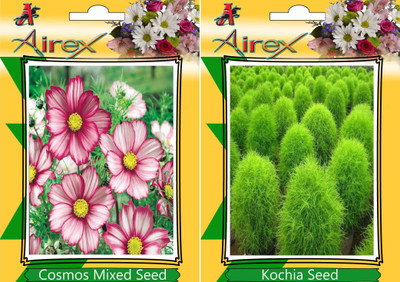Airex Cosmos Mixed, Kochia Seed(15 per packet)
Quick Overview
Product Price Comparison
COSMOS: Cosmos are herbaceous perennial plants or annual plants growing 0.3ŌĆō2 m (1 ft 0 inŌĆō6 ft 7 in) tall. The leaves are simple, pinnate, or bipinnate, and arranged in opposite pairs. The flowers are produced in a capitulum with a ring of broad ray florets and a center of disc florets; flower color is very variable between the different species. The genus includes several ornamental plants popular in gardens. Numerous hybrids and cultivars have been selected and named. Kochia: Kochia (Kochia scoparia (L.) Roth), also known as fireweed, burning bush or summer cypress, was introduced to the United States around 1900 as an ornamental from Eurasia. Gardeners like this annual plant for its bright red foliage in autumn. Farmers in dry areas, including the Southwest, have grown kochia as a drought-resistant forage crop on lands where other crops are difficult to grow -- hence the nickname "poor man's alfalfa." Because of kochia's low water requirements and resistance to diseases and insects, interest in it as a forage crop has increased in the last decade. Researchers at South Dakota State College have selected seeds from wild plants and produced satisfactory yields of leafy foliage. Kochia, with its high protein content, requires relatively large amounts of nitrogen (100 to 250 lb/acre). If too much nitrogen is applied at once, however, toxic levels of nitrate may accumulate in the plants. Oxalate toxicity, which causes rough hair, humpback, jaundice, photosensitization and a stiff gait in livestock, is another potential problem for cattle that graze only on kochia for periods of 90 to 120 days. Kochia grows wild throughout most of the northern half of the United States, except for parts of the Pacific Northwest. The plant has become a serious drought-resistant weed in the Plains states. Because of the wide genetic variability in wild kochia, it is possible that the problems associated with the plant as a forage crop can be overcome with plant breeding.


